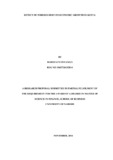| dc.description.abstract | In Kenya, foreign borrowing and economic growth have been on the rise over the years. The main objective of this study was to investigate the effect of Kenya’s foreign borrowing on its economy. Various empirical studies have revealed contradicting results on the relationship between these two variables both locally and internationally. The current study was motivated by lack of similar studies covering same period and methodology in Kenya. So as to determine comparative relationship between dependent and the predictor variables, control variables were incorporated in to the study. These were Inflation, Foreign Direct Investment, Exchange Rate, Terms of Trade and Interest rate. The study covered a period of 40 years as from 1975 to 2014 with the seven variables. Secondary data was used and this was collected from Central Bank of Kenya website, the World Bank Website and from the Kenya National Bureau of Statistics website. The software used in the analysis was SPSS version 20.This was useful in generating outcome reports like the descriptive statistics, correlation output for the dependent and independent variables, multiple regression analysis output. Ms. Office Excel was used to demonstrate the trend of the dependent and independent variables graphically. The graphical output revealed a general upward trend of both the economic growth and the foreign debt. SPSS output results showed that 80.40% of the changes in Kenya’s economic growth was explained by the model. The F statistic (22.57) was significant at 5% level. Further, the study revealed that exchange rate and FDI had a significant effect on economic growth. ToT revealed a positive relationship, however this was not significant at 5%.However, the effect of both interest rate and inflation on economic growth was negative. The study further revealed that 36.72% of the GDP fluctuations in Kenya was influenced by foreign debt. Lastly the study concludes that Kenya’s foreign debt positively affects GDP growth and this was consistent with Keynesian Model and some empirical studies as highlighted in this context. While there was a good attempt at exploring other factors which influence economic growth other than foreign debt, it cannot be claimed that the factors used in this study are exhaustive. Thus there are other factors which were left out of this study hence the model used may be limited in this respect. Therefore, this study recommends a similar study with a larger sample and more variables to be carried out especially in Africa, where most of the countries are deemed net borrowers. | en_US |



